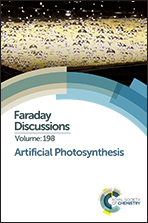Photocatalytic H2 production on trititanate nanotubes coupled with CdS and platinum nanoparticles under visible light: revisiting H2 production and material durability†
Abstract
The photocatalytic production of molecular hydrogen (H2) on ternary composites of Pt, CdS, and sodium trititanate nanotubes (NaxH2−xTi3O7, TNTs) is examined in an aqueous 2-propanol (IPA) solution (typically 5 vol%) at a circum-neutral pH under visible light (λ > 420 nm). The H2 production rates are dependent on the Pt-loading level, and the optimum production rate in the Pt/CdS/TNTs is approximately six times higher than that in Pt/CdS/TiO2. A D2O solution containing 5 vol% IPA leads only to the production of D2 molecules, whereas increasing the IPA amount to 30 vol% leads to the production of DH molecules. This indicates that the Pt/CdS/TNTs composites enable H2 production via true water splitting under our typical experimental conditions. X-ray photoelectron spectroscopy (XPS) analyses of the as-synthesized Pt/CdS/TNTs and those used for 6 and 12 h show that metallic Pt on the CdS/TNTs is less susceptible to oxidation than Pt on CdS/TiO2. In addition, photocorrosion of CdS (i.e., sulfate formation) is significantly inhibited during the photocatalytic H2 production reactions in the Pt/CdS/TNTs because of the efficient charge transfer via the TNTs framework. The Pt/CdS/TNTs samples are thermally more stable than Pt/CdS/TiO2 and CdS/TNTs, effectively inhibiting the formation of CdO during the thermal synthesis. Detailed surface characterizations of the as-synthesized ternary composites are performed using X-ray diffraction, transmission electron microscopy, energy dispersive spectroscopy, and XPS.
- This article is part of the themed collection: Artificial Photosynthesis

 Please wait while we load your content...
Please wait while we load your content...